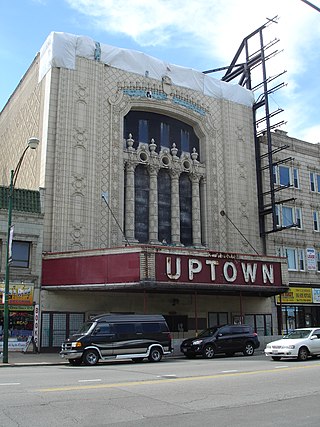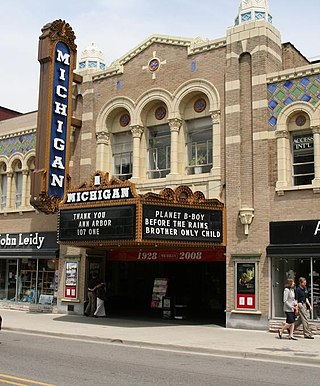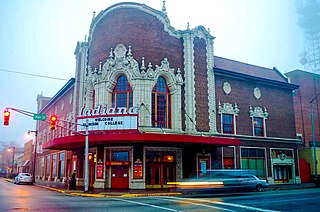
A movie palace is any of the large, elaborately decorated movie theaters built between the 1910s and the 1940s. The late 1920s saw the peak of the movie palace, with hundreds opening every year between 1925 and 1930. With the advent of television, movie attendance dropped, while the rising popularity of large multiplex chains in the 1980s and 1990s signaled the obsolescence of single-screen theaters. Many movie palaces were razed or converted into multiple-screen venues or performing arts centers, though some have undergone restoration and reopened to the public as historic buildings.

The Michigan Theater is a movie palace in Ann Arbor, Michigan, United States, near the Central Campus of the University of Michigan. It shows independent films and stage productions, and hosts musical concerts.

The Grand Lake Theatre is a historic movie palace located at 3200 Grand Avenue and Lake Park Avenue in the Grand Lake neighborhood of Oakland, California.
Goodrich Theater NewCo, LLC. is a chain of 22 movie theaters, headquartered in Grand Rapids, MI, representing a total of 174 screens in the United States. The majority of GQT Movies' locations are in Michigan, but other locations could be found in Illinois, Indiana, Missouri, Alabama, and Pennsylvania. The company filed for Chapter 11 Bankruptcy protection in February 2020. All employees were terminated March 19, 2020 without notice largely due to the COVID-19 pandemic, as many movie theaters were closed by government order in many states. In last July 2020, the company began reopening some of their locations. By the end of the year it had reopened its 22 locations.

The State Theatre is a movie theater in Traverse City, Michigan. In its current iteration, it is operated by the Traverse City Film Festival, and presents a year-round schedule of film and live performances.

The Hollywood Theatre is a historic movie theater in northeast Portland, Oregon, owned by a non-profit organization. It is a central historical landmark of the Hollywood District. The Theatre is located at 4122 NE Sandy Blvd, across the street from the first suburban Fred Meyer store, which is currently occupied by Rite Aid. The Hollywood Theatre was placed on the National Register of Historic Places in 1983 and is considered to be a gem of Northeast Portland's historic culture and tradition.

The Michigan Theatre at 124 North Mechanic Street in Jackson, Michigan opened in 1930 and was designed by Maurice Herman Finkel. It was listed on the National Register of Historic Places on May 8, 1980, and is undergoing renovations as of 2005.

The Gillioz Theatre is a historic theater located at Springfield, Missouri, United States. It was built by M. E. Gillioz of Monett, Missouri. Mr. Gillioz was in the business of building bridges, and the theater was built with steel and concrete. Wood was only used for handrails, doors, and doorframes. The original cost of the building was $300,000. Renovation costs totaled approximately $1.9 million.

Keith-Albee Theatre is a performing arts center located along Fourth Avenue in downtown Huntington, West Virginia, United States. The Keith-Albee was named after the Keith-Albee-Orpheum Corporation, one of the leading vaudeville performance chains at that time, to convince the directors of Keith-Albee-Orpheum to make the Keith-Albee a regular stop. At the time of its construction, The Keith Albee was the second largest theater in the U.S. It is listed on the National Register of Historic Places as part of the Downtown Huntington Historic District, and is currently being restored as a performing arts center.

The Somerville Theatre is an independent movie theater and concert venue in the Davis Square neighborhood of Somerville, Massachusetts, United States. Over one hundred years old, the Somerville Theatre started off as a vaudeville house and movie theater. The theater has since transitioned and now operates as a live music venue and first-run movie theater. As a music venue, the theater has played host to many historic concerts, including the first of the two Last Dispatch concerts, two shows by Bruce Springsteen in 2003, and a performance by U2 in 2009. Recent live performances have included Ryan Adams & the Cardinals, Cursive, Norah Jones, The Jonas Brothers, Joan Baez, and the John Butler Trio.

An atmospheric theatre is a type of movie palace design which was popular in the late 1920s. Atmospheric theatres were designed and decorated to evoke the feeling of a particular time and place for patrons, through the use of projectors, architectural elements and ornamentation that evoked a sense of being outdoors. This was intended to make the patron a more active participant in the setting.

Ramona Park was an amusement park located in the city of East Grand Rapids, Michigan between 1897 and 1955. The Park included a double track wooden roller coaster, a theater pavilion, a ridable miniature railway and boat livery.

The State Theatre is a movie palace in Ann Arbor, Michigan, designed by C. Howard Crane in the Art Deco style.

The Ramsdell Theatre is a historic playhouse theater building and opera house at 101 Maple Street in downtown Manistee, Michigan. The building was financed by local businessman and politician Thomas Jefferson Ramsdell and was built in 1902. It replaced the town's two previous opera houses which had been destroyed by fire, one in 1882 and the other in 1900. Besides producing plays the facility was later used as a movie theater. James Earl Jones started his acting career at the theater as an actor and stage manager.

The Alger Theater is a theatre located at 16451 East Warren Avenue in the MorningSide neighborhood of Detroit, Michigan. It is one of only two remaining intact and unchanged neighborhood theaters in the city of Detroit. It was listed on the National Register of Historic Places in 2005.

Englert Theatre in Iowa City, Iowa, is a renovated vaudeville-era playhouse now serving as a community arts center and 725-seat performance venue. It is owned and operated year around by Englert Civic Theatre, a non-profit art organization. The building was individually listed on the National Register of Historic Places in 2001. In 2021, it was included as a contributing property in the Iowa City Downtown Historic District.

The Hanover Theatre and Conservatory for the Performing Arts in Worcester, Massachusetts, United States was originally built in 1904 as the Franklin Square Theatre regularly scheduling burlesque shows, Broadway touring shows and headline acts transitioning to showing silent films by 1912 when vaudeville magnate Sylvester Poli purchased the theatre from the estate of Pauline L. Taylor.

The Indiana Theatre is a historic theater in Terre Haute, Indiana, United States. It was added to the National Register of Historic Places on November 13, 1997 and is located in the Wabash Avenue-East Historic District. It opened on January 28, 1922. The theatre was built by Terre Haute resident T. W. Barhydt and was designed by John Eberson. Eberson, who later developed the atmospheric theater style of movie palace, first experimented with atmospheric design elements at the theatre. Eberson stated, "Into this Indiana Theatre I have put my very best efforts and endeavors in the art of designing a modern theatre such as I have often pictured as what I would do were I given a free hand." Through this quote Eberson suggests that the Indiana Theatre embodies the raw beginning of his experiment with a "dream" theater that marked the beginning shift to his atmospheric style.


















